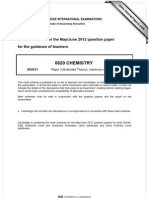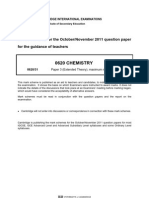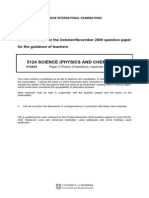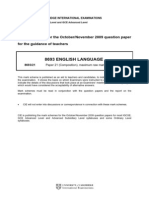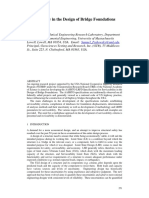0 ratings0% found this document useful (0 votes)
44 views5129 w12 Ms 22
5129 w12 Ms 22
Uploaded by
mstudy123456Cambridge is publishing the mark schemes for the October / November 2012 series for most IGCSE, GCE Advanced Level and Advanced Subsidiary Level components and some Ordinary Level components.
Copyright:
© All Rights Reserved
Available Formats
Download as PDF, TXT or read online from Scribd
5129 w12 Ms 22
5129 w12 Ms 22
Uploaded by
mstudy1234560 ratings0% found this document useful (0 votes)
44 views7 pagesCambridge is publishing the mark schemes for the October / November 2012 series for most IGCSE, GCE Advanced Level and Advanced Subsidiary Level components and some Ordinary Level components.
Original Title
5129_w12_ms_22
Copyright
© © All Rights Reserved
Available Formats
PDF, TXT or read online from Scribd
Share this document
Did you find this document useful?
Is this content inappropriate?
Cambridge is publishing the mark schemes for the October / November 2012 series for most IGCSE, GCE Advanced Level and Advanced Subsidiary Level components and some Ordinary Level components.
Copyright:
© All Rights Reserved
Available Formats
Download as PDF, TXT or read online from Scribd
Download as pdf or txt
0 ratings0% found this document useful (0 votes)
44 views7 pages5129 w12 Ms 22
5129 w12 Ms 22
Uploaded by
mstudy123456Cambridge is publishing the mark schemes for the October / November 2012 series for most IGCSE, GCE Advanced Level and Advanced Subsidiary Level components and some Ordinary Level components.
Copyright:
© All Rights Reserved
Available Formats
Download as PDF, TXT or read online from Scribd
Download as pdf or txt
You are on page 1of 7
CAMBRIDGE INTERNATIONAL EXAMINATIONS
GCE Ordinary Level
MARK SCHEME for the October/November 2012 series
5129 COMBINED SCIENCE
5129/22 Paper 2 (Theory), maximum raw mark 100
This mark scheme is published as an aid to teachers and candidates, to indicate the requirements of
the examination. It shows the basis on which Examiners were instructed to award marks. It does not
indicate the details of the discussions that took place at an Examiners meeting before marking began,
which would have considered the acceptability of alternative answers.
Mark schemes should be read in conjunction with the question paper and the Principal Examiner
Report for Teachers.
Cambridge will not enter into discussions about these mark schemes.
Cambridge is publishing the mark schemes for the October/November 2012 series for most IGCSE,
GCE Advanced Level and Advanced Subsidiary Level components and some Ordinary Level
components.
Page 2 Mark Scheme Syllabus Paper
GCE O LEVEL October/November 2012 5129 22
Cambridge International Examinations 2012
1 glands
blood
target
liver [4]
2 (a) W = Fd or 2.5 2.4 [1]
= 6.0 [1]
J (unit independent) [1]
(b) speed of rotation / falling weight
no. turns in coil
strength of magnetic field any two
area of coil
mass of weight [2]
ignore: size of coil, bigger magnet, speed alone and weight alone
3 (a) arrow vertically down (anywhere on diagram) [1]
(b) (i) P at beginning of path (above the building) [1]
(ii) K at end of path [1]
(c) rate of change of velocity / speed any 1
change in velocity / time [1]
4 (a) 2, 8 (ignore correct charge) [1]
(b) 80 12 [2]
8 1.2 (divide by 10) [1]
2 (divide by 4) [1]
ecf throughout
(c) ionic / electrovalent [1]
5 (a) concrete expands [1]
(b) path / concrete buckles any 1
path / concrete cracks / breaks [1]
ignore: destroy path / concrete
Page 3 Mark Scheme Syllabus Paper
GCE O LEVEL October/November 2012 5129 22
Cambridge International Examinations 2012
6 (a) (i) A = (cell) membrane
B = cytoplasm
C = nucleus [3]
(ii) controls / allows movement of substances into the cell any 1
controls / allows movement of chemicals out of the cell [1]
(b) [Note: explanation must match the difference.
Mark difference and explanation together]
difference no nucleus (in red blood cell)
explanation (cell can contain) more haemoglobin
(cell can carry) more oxygen
difference biconcave (disc) shape
explanation large surface area (per volume)
increased uptake of oxygen (in lung capillaries) any 2
increased release of oxygen (in tissue capillaries)
faster diffusion
ignore: easier to carry oxygen
difference flexible / small size of red blood cell
explanation cell can pass through capillaries rapidly [6]
7 (a) (i) gamma / [1]
(ii) alpha / [1]
(b) neutron changes into proton / p increase by 1 and n decrease by 1 [1]
do not accept: electrons change
(c) use tongs or gloves
keep distance from any 2
point source away from body
store in lead container / safely when not in use [2]
ignore: lead suit, goggles, safety gear, protective gear
8 (a) magnetic materials are attracted to magnets / can be magnetised any 1
non magnetic materials are not / cannot be magnetised [1]
Page 4 Mark Scheme Syllabus Paper
GCE O LEVEL October/November 2012 5129 22
Cambridge International Examinations 2012
(b) (i) steel is a hard magnetic material
steel retains magnetism / permanent
steel hard to magnetise any 1
iron is soft magnetic material
iron easily loses magnetism / temporary
iron easy to magnetise [1]
(ii) no difference/ none / no effect [1]
(iii) more turns
more current (voltage) / add more batteries [2]
(c) 0.8 [1]
9 (a) A = sulfuric (acid) / H
2
SO
4
B = water / H
2
O
C = copper / Cu [3]
(b) evaporate (some of the water) / heat / boil
filter the crystals
cool / crystallise any 1 [2]
ignore initial filtration
evaporate to dryness max 1 mark
(c) high melting / boiling point
conducts heat
conducts electricity
malleable any 2
ductile
shiny
high density
sonorous [2]
10 (a) a single seed may be defective / not all seeds germinate any 1
to give a fair test
some seeds might not work [1]
(b) (i) add water to the cotton wool [1]
(ii) all the oxygen has been absorbed / oxygen absorber (present)
without oxygen the cells cannot respire
respiration is necessary to release energy any 1
energy is needed for growth / germination [2]
(iii) temperature is too low / seeds are too cool / T is 4 C
reactions are too slow at low temperatures any 1
reference to enzymes working slowly / inactive at low T [2]
Page 5 Mark Scheme Syllabus Paper
GCE O LEVEL October/November 2012 5129 22
Cambridge International Examinations 2012
11 (a) (i) I = V/R or 1.0/2
= 0.5 [2]
(ii) 4.0 [1]
(b) (i) reduced / decrease [1]
(ii) reduced/ decrease [1]
12 (a) H
2
[1]
(b) zinc has gained oxygen
steam has lost oxygen [2]
accept correct explanations in terms of electrons or oxidation states
(c) (i) oxygen / O
2
water / H
2
O [2]
accept steam / water vapour
(ii) galvanising [1]
do not accept: sacrificial protection / electrolysis
13 (a) they are soluble in water
absorbed by root hair cell
diffusion any 2
cell has large surface area (per volume)
allow reference to active transport if given [2]
do not accept: osmosis
(b) (i) 2200 (kg per hectare) [1]
(ii) 80 kg per hectare gives yield of 8200 kg per hectare
40 kg per hectare gives yield of 5900 kg per hectare
8200 5900 = 2300 kg per hectare
(allow ecf for 1 mark if calculation is correct from incorrect readings) [2]
(iii) nitrogen (proteins) needed for growth
nitrogen needed to make amino acids / proteins [2]
(iv) 9100 9200 (kg per hectare) [1]
(c) conversion of light energy into chemical energy
production of carbohydrates / glucose any 2
plants are source of food / energy for animals
(animals need) oxygen (to breathe / respire)
maintenance of O
2
/ CO
2
balance in the atmosphere [2]
Page 6 Mark Scheme Syllabus Paper
GCE O LEVEL October/November 2012 5129 22
Cambridge International Examinations 2012
14 (a) C
n
H
2n
[1]
(b) (i) addition / reduction/ hydrogenation / redox [1]
(ii) (carbon to carbon) double bond / C=C [1]
(c) H H
( C C )
n
H H
open ended + repeat unit n times (below and after) (independent) [2]
15 (a) a blockage of the (coronary) arteries [1]
(b) high (animal) fat / cholesterol diet / obesity
high blood pressure
lack of exercise any 2
smoking
stressful life / life-style
family history
diabetes [2]
16 (a) 1.8 [1]
(b) 9.16 [1]
17 clockwise
anticlockwise all four correct = 2 marks
anticlockwise 2 or 3 correct = 1 mark
horizontal / balanced [2]
18 (a) three shared pairs
one lone pair [2]
(b) covalent
low
non-metal non-metal (1 mark for both) [3]
Page 7 Mark Scheme Syllabus Paper
GCE O LEVEL October/November 2012 5129 22
Cambridge International Examinations 2012
19 (a) 90 degrees to mirror where ray is incident [1]
(b) < incidence = < reflection (approx) [1]
(c) in approximately the correct position [1]
20 (a) carbon dioxide [1]
(b) acetylene and oxygen (both) [1]
(c) nitrogen [1]
(d) sulphur dioxide [1]
accept: correct formulae
You might also like
- 0620 Chemistry: MARK SCHEME For The May/June 2011 Question Paper For The Guidance of TeachersDocument6 pages0620 Chemistry: MARK SCHEME For The May/June 2011 Question Paper For The Guidance of TeachersAYSHAMOHD88No ratings yet
- Turbine Steam Inlet SystemDocument14 pagesTurbine Steam Inlet SystemDr-Amit Kumar SinghNo ratings yet
- Code 014 8 SPFLI ExampleDocument4 pagesCode 014 8 SPFLI ExampleMrYenThanhNo ratings yet
- 2018 ENG GBRX Internet PDFDocument95 pages2018 ENG GBRX Internet PDFDifermo100% (1)
- 12V2000 PDFDocument103 pages12V2000 PDFczarate1974100% (1)
- 5070 w12 Ms 21Document10 pages5070 w12 Ms 21mstudy123456No ratings yet
- 5129 w12 Ms 22 PDFDocument7 pages5129 w12 Ms 22 PDFBrendon MuriraNo ratings yet
- Form 4: IGCSE Chemistry Markscheme Paper 31 2012Document6 pagesForm 4: IGCSE Chemistry Markscheme Paper 31 2012Funny Atoms50% (2)
- 5070 Chemistry: MARK SCHEME For The October/November 2010 Question Paper For The Guidance of TeachersDocument7 pages5070 Chemistry: MARK SCHEME For The October/November 2010 Question Paper For The Guidance of Teachersmstudy123456No ratings yet
- MARK SCHEME For The June 2005 Question PaperDocument7 pagesMARK SCHEME For The June 2005 Question Papermstudy123456No ratings yet
- Chemistry Nov 07 Paper 2 Mark SchemeDocument7 pagesChemistry Nov 07 Paper 2 Mark SchemePhoolee0% (1)
- 5129 w08 Ms 2Document7 pages5129 w08 Ms 2mstudy123456No ratings yet
- 0620 Chemistry: MARK SCHEME For The May/June 2012 Question Paper For The Guidance of TeachersDocument6 pages0620 Chemistry: MARK SCHEME For The May/June 2012 Question Paper For The Guidance of TeachersAbrar Abdallah SiamNo ratings yet
- 0620 Chemistry: MARK SCHEME For The May/June 2013 SeriesDocument5 pages0620 Chemistry: MARK SCHEME For The May/June 2013 Seriesghayuhh :1No ratings yet
- 5070 Chemistry: MARK SCHEME For The May/June 2013 SeriesDocument8 pages5070 Chemistry: MARK SCHEME For The May/June 2013 SeriesAliya KhalidNo ratings yet
- 5124 Science (Physics and Chemistry)Document5 pages5124 Science (Physics and Chemistry)mstudy123456No ratings yet
- 0620 w11 Ms 31Document5 pages0620 w11 Ms 31Ahlam AbdullahNo ratings yet
- 0620 w11 Ms 32Document6 pages0620 w11 Ms 32skglkNo ratings yet
- 5070 s10 Ms 21Document7 pages5070 s10 Ms 21Sherlock Wesley ConanNo ratings yet
- Chemistry Markscheme (All in One)Document728 pagesChemistry Markscheme (All in One)AliMushtaq50% (2)
- 0620 w11 Ms 33Document5 pages0620 w11 Ms 33saffwanNo ratings yet
- 0620 w10 Ms 32Document6 pages0620 w10 Ms 32fairy56No ratings yet
- 0620 w13 Ms 31Document5 pages0620 w13 Ms 31Haider AliNo ratings yet
- 5070 Chemistry: MARK SCHEME For The October/November 2009 Question Paper For The Guidance of TeachersDocument8 pages5070 Chemistry: MARK SCHEME For The October/November 2009 Question Paper For The Guidance of Teachersatul purnaNo ratings yet
- 0653 w16 Ms 31Document5 pages0653 w16 Ms 31yuke kristinaNo ratings yet
- 5070 s10 Ms 22 PDFDocument10 pages5070 s10 Ms 22 PDFNeural Spark Physics CieNo ratings yet
- 0620 Chemistry: MARK SCHEME For The October/November 2014 SeriesDocument6 pages0620 Chemistry: MARK SCHEME For The October/November 2014 SeriesMr HeckerNo ratings yet
- June 2011 (v1) MS - Paper 6 CIE Chemistry IGCSEDocument4 pagesJune 2011 (v1) MS - Paper 6 CIE Chemistry IGCSEAngelina AnneNo ratings yet
- 5070 w08 Ms 2Document10 pages5070 w08 Ms 2mstudy123456No ratings yet
- 0620 s03 Ms 1+2+3+5+6 PDFDocument18 pages0620 s03 Ms 1+2+3+5+6 PDFSumaira AliNo ratings yet
- 0620 Chemistry: MARK SCHEME For The May/June 2010 Question Paper For The Guidance of TeachersDocument6 pages0620 Chemistry: MARK SCHEME For The May/June 2010 Question Paper For The Guidance of TeachersHaris AwanNo ratings yet
- 5070 Chemistry: MARK SCHEME For The October/November 2015 SeriesDocument7 pages5070 Chemistry: MARK SCHEME For The October/November 2015 SeriesMushtaq AhmedNo ratings yet
- 5124 Science (Physics and Chemistry)Document5 pages5124 Science (Physics and Chemistry)mstudy123456No ratings yet
- 9701 Chemistry: MARK SCHEME For The May/June 2010 Question Paper For The Guidance of TeachersDocument6 pages9701 Chemistry: MARK SCHEME For The May/June 2010 Question Paper For The Guidance of TeachersSumaira AliNo ratings yet
- 0653 Combined Science: MARK SCHEME For The May/June 2015 SeriesDocument6 pages0653 Combined Science: MARK SCHEME For The May/June 2015 SeriesRudra KumarNo ratings yet
- 0620 Chemistry: MARK SCHEME For The March 2015 SeriesDocument6 pages0620 Chemistry: MARK SCHEME For The March 2015 SeriesNandanVenkatesan0% (1)
- 0620 s07 Ms 2Document8 pages0620 s07 Ms 2Varun PanickerNo ratings yet
- Mark Scheme: November 2001Document5 pagesMark Scheme: November 2001Varun PanickerNo ratings yet
- 5070 w14 Ms 21Document10 pages5070 w14 Ms 21ShapolaMutyokaNo ratings yet
- MARK SCHEME For The November 2004 Question PaperDocument9 pagesMARK SCHEME For The November 2004 Question Papermstudy123456No ratings yet
- 0620 Chemistry: MARK SCHEME For The May/June 2013 SeriesDocument6 pages0620 Chemistry: MARK SCHEME For The May/June 2013 SeriesShad muhammad KhanNo ratings yet
- 0620 s13 Ms 32 PDFDocument6 pages0620 s13 Ms 32 PDFShad muhammad KhanNo ratings yet
- 5070 Chemistry: MARK SCHEME For The October/November 2010 Question Paper For The Guidance of TeachersDocument10 pages5070 Chemistry: MARK SCHEME For The October/November 2010 Question Paper For The Guidance of Teachersatul purnaNo ratings yet
- 0620 Chemistry: MARK SCHEME For The May/June 2010 Question Paper For The Guidance of TeachersDocument4 pages0620 Chemistry: MARK SCHEME For The May/June 2010 Question Paper For The Guidance of TeachersVarun PanickerNo ratings yet
- 0653 s16 Ms 33Document5 pages0653 s16 Ms 33yuke kristinaNo ratings yet
- 0620 m15 Ms 22Document6 pages0620 m15 Ms 22sookchinNo ratings yet
- Paper 2 Nov 2006Document6 pagesPaper 2 Nov 2006MSHNo ratings yet
- Physical Science Paper 2 November 2009Document10 pagesPhysical Science Paper 2 November 2009BRANDON TINASHENo ratings yet
- 2016 Specimen Paper 4 Mark SchemeDocument6 pages2016 Specimen Paper 4 Mark SchemelolismNo ratings yet
- 9701 Chemistry: MARK SCHEME For The October/November 2010 Question Paper For The Guidance of TeachersDocument6 pages9701 Chemistry: MARK SCHEME For The October/November 2010 Question Paper For The Guidance of Teachersdevimayabhattarai52No ratings yet
- Chemistry Paper 2 SL MarkschemeDocument14 pagesChemistry Paper 2 SL MarkschemeSonia InezaNo ratings yet
- 11-OL - Kinetic Theory 70Document46 pages11-OL - Kinetic Theory 70Mobeen ur RehmanNo ratings yet
- 5124 w09 Ms 3Document5 pages5124 w09 Ms 3mstudy123456No ratings yet
- 0620 Chemistry: MARK SCHEME For The May/June 2010 Question Paper For The Guidance of TeachersDocument4 pages0620 Chemistry: MARK SCHEME For The May/June 2010 Question Paper For The Guidance of TeachersVarun Panicker100% (1)
- 0620 Chemistry: MARK SCHEME For The May/June 2010 Question Paper For The Guidance of TeachersDocument5 pages0620 Chemistry: MARK SCHEME For The May/June 2010 Question Paper For The Guidance of TeachersVarun PanickerNo ratings yet
- MARK SCHEME For The November 2004 Question PaperDocument8 pagesMARK SCHEME For The November 2004 Question PaperVarun PanickerNo ratings yet
- Electricity & Chemistry 2 MSDocument4 pagesElectricity & Chemistry 2 MSSheikhNo ratings yet
- 0620 Chemistry: MARK SCHEME For The May/June 2013 SeriesDocument6 pages0620 Chemistry: MARK SCHEME For The May/June 2013 Seriescarlostibayan87No ratings yet
- 5070 w10 Ms 41Document4 pages5070 w10 Ms 41mstudy123456No ratings yet
- 2018 Specimen Paper 3 Mark SchemeDocument6 pages2018 Specimen Paper 3 Mark SchemeGiselle WijayaNo ratings yet
- Graphene Oxide: Fundamentals and ApplicationsFrom EverandGraphene Oxide: Fundamentals and ApplicationsAyrat M. DimievNo ratings yet
- Hyrdogen Storage TechnologiesFrom EverandHyrdogen Storage TechnologiesMehmet SankirNo ratings yet
- Printable Solar CellsFrom EverandPrintable Solar CellsNurdan Demirci SankirNo ratings yet
- 0654 w04 Ms 6Document6 pages0654 w04 Ms 6mstudy123456No ratings yet
- 0547 s06 TN 3Document20 pages0547 s06 TN 3mstudy123456No ratings yet
- 0486 w09 QP 4Document36 pages0486 w09 QP 4mstudy123456No ratings yet
- Literature (English) : International General Certificate of Secondary EducationDocument1 pageLiterature (English) : International General Certificate of Secondary Educationmstudy123456No ratings yet
- 9701 s06 Ms 4Document5 pages9701 s06 Ms 4Kenzy99No ratings yet
- Frequently Asked Questions: A/AS Level Sociology (9699)Document1 pageFrequently Asked Questions: A/AS Level Sociology (9699)mstudy123456No ratings yet
- 9694 s11 QP 21Document8 pages9694 s11 QP 21mstudy123456No ratings yet
- University of Cambridge International Examinations General Certificate of Education Advanced LevelDocument2 pagesUniversity of Cambridge International Examinations General Certificate of Education Advanced Levelmstudy123456No ratings yet
- 9694 w10 QP 23Document8 pages9694 w10 QP 23mstudy123456No ratings yet
- 8693 English Language: MARK SCHEME For The October/November 2009 Question Paper For The Guidance of TeachersDocument4 pages8693 English Language: MARK SCHEME For The October/November 2009 Question Paper For The Guidance of Teachersmstudy123456No ratings yet
- 9719 SPANISH 8685 Spanish Language: MARK SCHEME For The May/June 2009 Question Paper For The Guidance of TeachersDocument3 pages9719 SPANISH 8685 Spanish Language: MARK SCHEME For The May/June 2009 Question Paper For The Guidance of Teachersmstudy123456No ratings yet
- English Language: PAPER 1 Passages For CommentDocument8 pagesEnglish Language: PAPER 1 Passages For Commentmstudy123456No ratings yet
- 8679 w04 ErDocument4 pages8679 w04 Ermstudy123456No ratings yet
- 8780 w12 QP 1Document16 pages8780 w12 QP 1mstudy123456No ratings yet
- First Language Spanish: Paper 8665/22 Reading and WritingDocument6 pagesFirst Language Spanish: Paper 8665/22 Reading and Writingmstudy123456No ratings yet
- D 4675 - 00 - Rdq2nzutukveDocument21 pagesD 4675 - 00 - Rdq2nzutukveStuartNo ratings yet
- ENGLISH Presentation TECPESA 2014 PDFDocument50 pagesENGLISH Presentation TECPESA 2014 PDFalexandermattos8513No ratings yet
- 14 MachinesDocument24 pages14 MachinesNdomaduNo ratings yet
- Fettweis ICT ENERGY CONSUMPTION - TRENDS AND CHALLENGESDocument4 pagesFettweis ICT ENERGY CONSUMPTION - TRENDS AND CHALLENGESPavlos ZirNo ratings yet
- FAA - Pilot - HandbookDocument524 pagesFAA - Pilot - HandbookBruno Barros100% (5)
- FuhjgDocument1 pageFuhjgAMAR KUMARNo ratings yet
- TSAUtility Survey Guidance Notes Issue 4 Low Res 1Document61 pagesTSAUtility Survey Guidance Notes Issue 4 Low Res 1divizioniNo ratings yet
- Medicall Delhi 2024 - DirectoryDocument298 pagesMedicall Delhi 2024 - DirectoryINFO CEMARKINGNo ratings yet
- OBIEE - Dashboard Tips and Best Practice GuidelinesDocument6 pagesOBIEE - Dashboard Tips and Best Practice GuidelinesPani GummadiNo ratings yet
- Complexity Space N TimeDocument36 pagesComplexity Space N Timeapi-3814408100% (4)
- 1.2 Beams With Uniform Load and End Moments: CHAPTER 1: Analysis of BeamsDocument8 pages1.2 Beams With Uniform Load and End Moments: CHAPTER 1: Analysis of Beamsfabricio88No ratings yet
- Kas-Cc JC - BS2P2 - MS - Qa-010 - Box - Culvert - Casted - in Situ - Rev.0Document16 pagesKas-Cc JC - BS2P2 - MS - Qa-010 - Box - Culvert - Casted - in Situ - Rev.0Antonio Tomas Gonzalez LosaNo ratings yet
- K.Natarajan: Siemens LimitedDocument3 pagesK.Natarajan: Siemens LimitedNivetha VenkateswaranNo ratings yet
- 1848 N. Lincoln Ave. Opposition LettersDocument17 pages1848 N. Lincoln Ave. Opposition LettersKelly BauerNo ratings yet
- Evaporation Chemical Engineering Series 2 PDF FreeDocument52 pagesEvaporation Chemical Engineering Series 2 PDF FreeBagus Dina AkadahNo ratings yet
- Fundamentals of Rockets & MissilesDocument20 pagesFundamentals of Rockets & MissilesMaria SultanaNo ratings yet
- SPE-37054-MS (Bit Torque Calculation) PDFDocument9 pagesSPE-37054-MS (Bit Torque Calculation) PDFWindy MartdianzahNo ratings yet
- Module For OshDocument2 pagesModule For OshHassahDah SeRolfalliv LaDivNo ratings yet
- Principles of SizingDocument24 pagesPrinciples of SizingraghunathNo ratings yet
- STRUCTURALDocument12 pagesSTRUCTURALJeni RouxzNo ratings yet
- NCERT Science Lab Manual X Expt 48 PDFDocument5 pagesNCERT Science Lab Manual X Expt 48 PDFAlpha KingNo ratings yet
- Computerized System of Graduate Students of NPCMSTDocument36 pagesComputerized System of Graduate Students of NPCMSTromeofatima100% (1)
- Serviceability in The Design of Bridge FoundationsDocument11 pagesServiceability in The Design of Bridge FoundationsAnton Husen PurboyoNo ratings yet
- Christopher AbabanDocument2 pagesChristopher AbabanRana Ahsan AliNo ratings yet
- Ghasemi and BasuDocument11 pagesGhasemi and BasuPreethiNo ratings yet
- 1SAP280000R0001 Sm560 Sac500 Safety Module CpuDocument2 pages1SAP280000R0001 Sm560 Sac500 Safety Module CpuSharjeel AbidNo ratings yet







